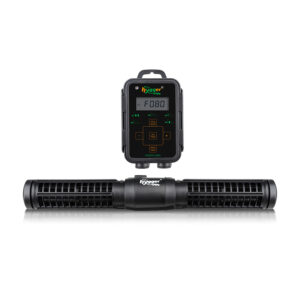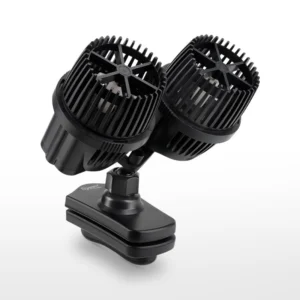Reef tanks demand higher flow rates than usual tanks. Besides the flow rate, it also requires wave patterns for different reefs and many other things. There is also a need to check other specifications while selecting a pump to make waves in a reef tank. All of these requirements, along 2 the best pumps in flow and other aspects, are also part of this article. Scroll down and learn about the best products and some qualities of the best pump and flow.
Content Table

The Purpose of a Flow Pump in Aquariums
A flow pump is among the most required components of any aquarium. The core purpose of any flow pump is to keep the aquarium water circulating. With this, there are several other benefits that aquarists get.
Water Circulation
The flow pump creates the current in the aquarium’s water, Which keeps it in circulation. It also helps in uniform nutrient distribution, maintaining the water temperature, avoiding dead zones, and proper oxygenation in the tank.
Maintain the Water Quality
Water agitation keeps the water quality at its best, ultimately benefiting fish and corals.
Filtration Improvement
Flow pumps help to avoid the piling up of uneaten food and pet waste and keep it in suspension. They direct this waste toward the filtration system. The filtration system rejects it from the tank. With this, you can avoid the ammonia spike in the tank.
Enhance Oxygenation
Oxygen is vital for health and overall well-being of life. Flow pumps agitate the water surface and help to exchange the gas between the surface and the atmosphere. This gas exchange helps to enhance the oxygen level in the water.
Nutrient Distribution
Nutrients are vital for aquarium plants as it helps in photosynthesis. Flow pumps equally distribute the nutrients in the tank. With this, each plant receives the proper nutrient share for its optimal growth.
Temperature Distribution
Flow pumps keep the water moving, maintain equal water temperature, and avoid temperature stratification. Temperature stratification is a phenomenon in which water stays stagnant and has different temperatures at the surface and bottom.
Avoid Algae Growth
Algae bloom is one of the major issues in fish tanks. Dead zones promote algae growth. Flow pumps help to avoid creating dead zones in the aquarium.

Reef Tank’s Best Pump and Flow
Reef tanks require some extra and versatile types of flow. A pump should have some specific attributes to meet these requirements. These qualities are in the following.
Flow Rate Requirement
Reef tanks need a higher flow rate than regular tanks. This flow rate varies according to reef type.
Soft Coral Reef Tanks & LPS (Large Polyp Stony) Coral Reef Tanks
The flow rate should be 20 times the tank’s volume. For example, for a 100-gallon tank, the flow rate should be 2,000 GPH.
SPS (Small Polyp Stony) Coral Reef Tanks
It requires the highest flow rate, i.e., 50 times the tank volume. For example, the flow rate for a 150-gallon tank should be 7,500 GPH.
Mixed Reef Tanks
Such tanks consist of soft, LPS, and SPS coral reefs. For such tanks, the flow rate should be 30 times of tank volume. Let’s say a tank of 100 gallons requires a pump that generates a flow rate of 3,000 GPM.
Other Pump Qualities
There are some other reef tank pump qualities.
Multiple Flow Patterns
The pumps that make waves in reef tanks are desired. Coral reefs require a combination of both laminar and turbulent flow. It helps to avoid nutrients and waste accumulation.
Adjustable Flow Rate
The pump should execute the flow rate adjustability. Varying flow rates are suitable because flow rate varies among different corals and different growth stages. Moreover, adjustability helps to make waves in a reef tank.
Direction Adjustability
Adjustability in flow direction also helps to clean the tank and maintain the growth of coral reefs at different growth stages.
Noise Level
High-flow rate flow pumps usually produce loud noise. If you are keeping your reef tank in the living, then select a minute-level noise-producing flow pump.
Thermal Safety
Coral reef pumps produce a higher flow rate than usual tanks. When a pump continuously operates at a high flow rate, then the pump body heats up and can prove problematic. Therefore, you need to check the thermal safety of it.
Higher Energy Efficiency
The pump should execute high energy efficiency. It should require low energy and deliver higher output. Moreover, the pump with low maintenance requirement is one of the best options.

How to Make Beach Waves in Reef Tanks
You can make waves in a reef tank with a wave maker or flow pump. There are several ways to achieve it.
| Place a hurdle in the flow path | Random flow pattern | Set the surge mood |
Usually, the maker provides a manual to make different waves with different adjustments. Here are different intensities of flow rates to make various waves in coral reefs.
Soft Corals
Soft corals need gentle to moderate waves. They thrive under low to moderate currents. Gentle oscillating currents help to sway their polyps. In strong currents, it will blast.
LPS Coral Tanks
These corals require moderate wave intensity. However, you can adjust the moderate to high flow intensity. Brod and laminar flow is optimal for such tank setups.
SPS Coral Tanks
These high flow rates required tank setups to do well with turbulent flow patterns. The turbulent flow is required for proper nutrient distribution and proper waste removal.
Mixed Coral Tanks
Here, you need to install different flow rate pumps. Operate them simultaneously to make a variety of waves in a reef tank. It helps in the growth of all corals in a mixed environment.

Choosing a Reef Tank Flow Pump
On buying a flow pump, look at the characteristics, pros, and cons. Here are two of the best pumps that help you set up multiple flow rates for your coral reef setup.
Pros
| Hygger 070 flow Wave Pump | 020 Double Head Wave Maker |
| Variable flow rate control, sufficient flow for larger tanks | Double the power for stronger water movement |
| Adjustable flow direction, cross-flow wave | Double fixed base for stability |
| Compact size, save space | Increased flow |
| Quiet operation, feeding functions | Strong magnet base for secure attachment |
| Energy-efficient | Easy adjustment with 360° rotating base |
| Waterproof motor for durability | Stainless steel shaft impeller for durability |
| Suitable for up to 9000L of tank | Suitable for 40-240 gallon tank |
Cons
| Hygger 070 flow Wave Pump | 020 Double Head Wave Maker |
| Limited to single-head design | Not suitable for small tanks under 40 gallons |
Considerations for Corals
| Hygger 070 flow Wave Pump | 020 Double Head Wave Maker |
| Suitable for soft, SPS, and LPS corals | Suitable for LPS and SPS corals |
| Adjustable flow rate allows for customization | Strong flow promotes nutrient distribution and growth |
| Gentle to moderate flow | Moderate to strong flow |
| Suitable for multi-layout | For complex aquascapes |
| Suitable for lower to high-flow | Go well with high-flow demand |
Final Thoughts
The flow pump is the heart of a reef aquarium. It continuously circulates the water, keeps it clean, and avoids dead zones and temperature stratification. Coral reef tanks are more unusual than the rest of the tanks. Therefore, it has different flow demands, i.e., its flow rate is usually at least 20 times the total tank volume. Moreover, while selecting a suitable one, flow patterns, thermal safety, and energy efficiency are other key factors.
The two best pumps with multiple flow rates can make it easy to decide on your future flow pump for a long time. You can go with the Hygger 070 flow Wave Pump for large tanks. While the 020 Double Head Wave Maker better serves middle to large tanks with LPS and SPS coral reef tanks.


Leave a comment